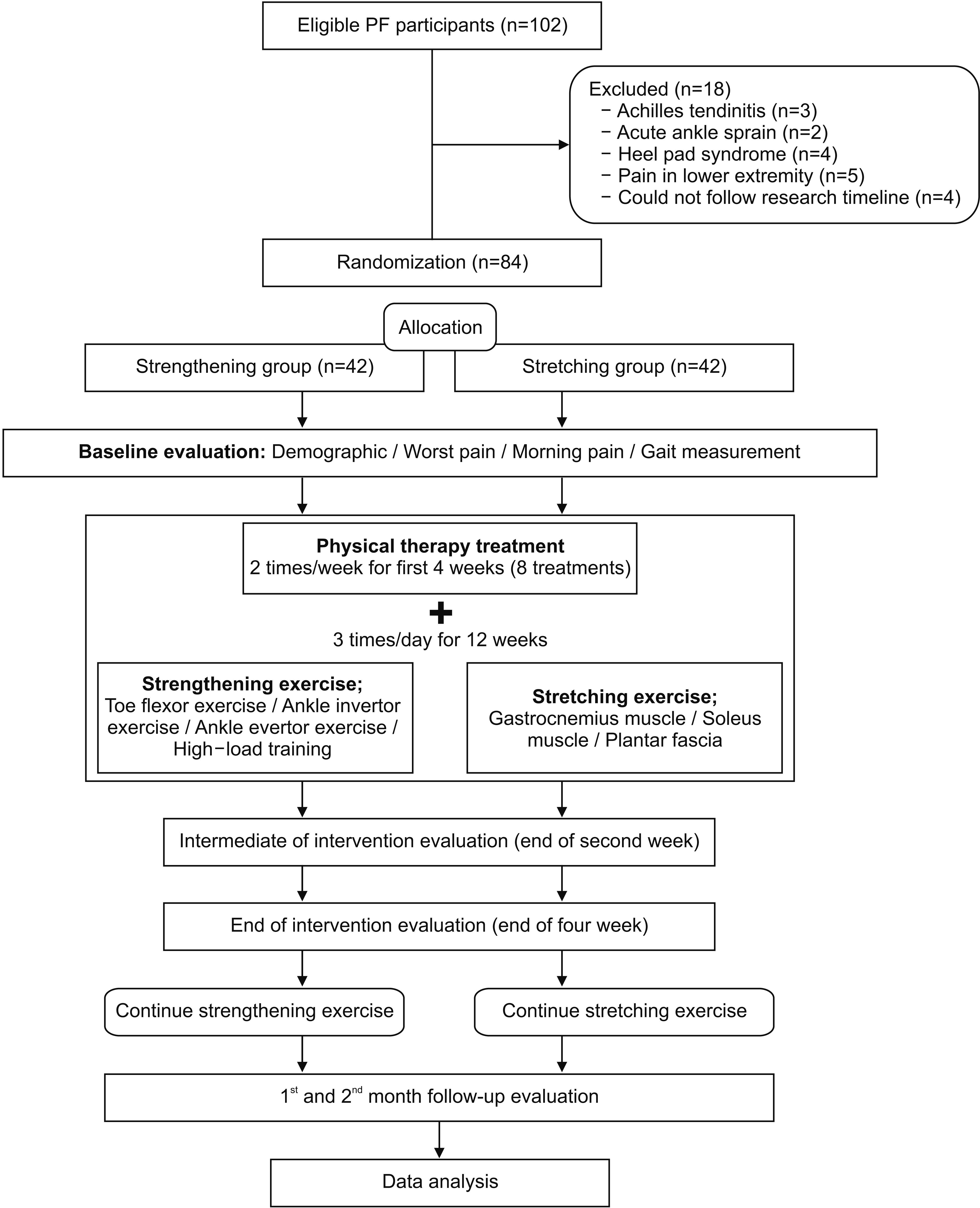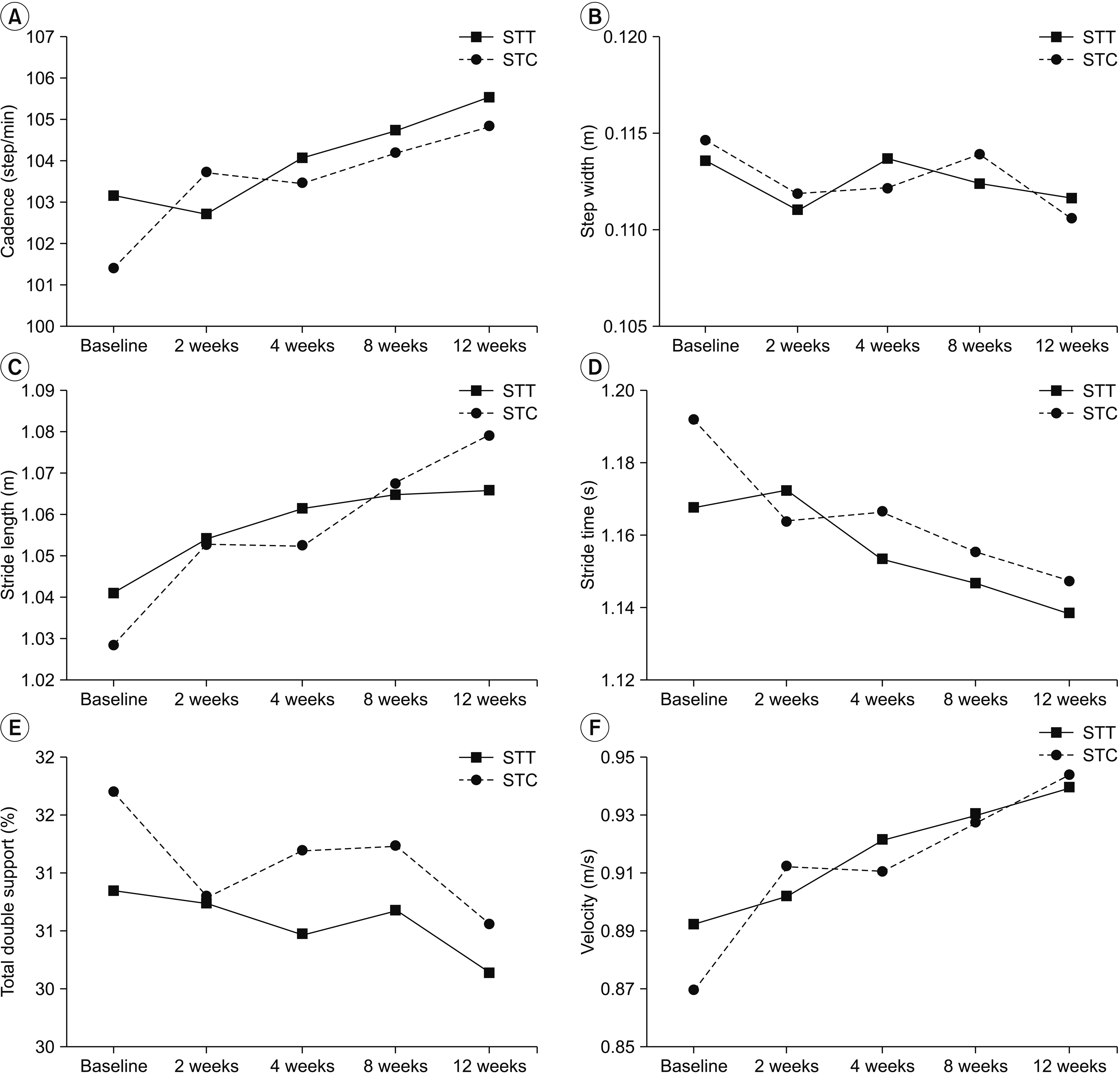Ann Rehabil Med.
2019 Dec;43(6):662-676. 10.5535/arm.2019.43.6.662.
Effects of Strengthening and Stretching Exercises on the Temporospatial Gait Parameters in Patients With Plantar Fasciitis: A Randomized Controlled Trial
- Affiliations
-
- 1Faculty of Physical Therapy, Mahidol University, Nakhon Pathom, Thailand. sunee.bov@mahidol.edu
- 2Physical Therapy Center, Faculty of Physical Therapy, Mahidol University, Bangkok, Thailand.
- 3Discipline of Exercise and Sport Science, Faculty of Health Science, The University of Sydney, Sydney, Australia.
- KMID: 2468693
- DOI: http://doi.org/10.5535/arm.2019.43.6.662
Abstract
OBJECTIVE
To investigate the effects of physical therapy interventions using strengthening and stretching exercise programs on pain and temporospatial gait parameters in patients with plantar fasciitis (PF).
METHODS
Eighty-four patients with PF participated in the study and were randomly assigned to the strengthening or stretching exercise groups. All patients received 8 physical therapy interventions two times per week in the first 4 weeks and performed daily strengthening or stretching exercises three times per day. After 4 weeks, they continued the assigned exercise programs every day for 8 weeks. Pain visual analogue scale (VAS) scores at the worst and in the morning and temporospatial gait parameters were evaluated at the baseline, intermediate of the intervention, end of the intervention, and the first and second month follow-up.
RESULTS
There were significant effects of the time on the worst pain, morning pain, cadence, stride time, stride length, total double support, and gait speed, but there was no effect on step width. In addition, the main effect of the group and the interaction effects of the time and the group were not found in any parameters. For intra-group comparisons, there were significant differences in worst pain, morning pain, cadence, and stride time among the assessment times in both groups. For inter-group comparisons, there were no significant differences in all parameters.
CONCLUSION
Both strengthening and stretching exercise programs significantly reduced pain and improved gait in patients with PF.
MeSH Terms
Figure
Reference
-
1. McPoil TG, Martin RL, Cornwall MW, Wukich DK, Irrgang JJ, Godges JJ. Heel pain: plantar fasciitis: clinical practice guidelines linked to the international classification of function, disability, and health from the orthopaedic section of the American Physical Therapy Association. J Orthop Sports Phys Ther. 2008; 38:A1–18.2. Cole C, Seto C, Gazewood J. Plantar fasciitis: evidence-based review of diagnosis and therapy. Am Fam Physician. 2005; 72:2237–42.3. Goff JD, Crawford R. Diagnosis and treatment of plantar fasciitis. Am Fam Physician. 2011; 84:676–82.4. Martin RL, Davenport TE, Reischl SF, McPoil TG, Matheson JW, Wukich DK, et al. Heel pain: plantar fasciitis: revision 2014. J Orthop Sports Phys Ther. 2014; 44:A1–33.5. Pfeffer G, Bacchetti P, Deland J, Lewis A, Anderson R, Davis W, et al. Comparison of custom and prefabricated orthoses in the initial treatment of proximal plantar fasciitis. Foot Ankle Int. 1999; 20:214–21.
Article6. Johnson RE, Haas K, Lindow K, Shields R. Plantar fasciitis: what is the diagnosis and treatment? Orthop Nurs. 2014; 33:198–204.7. McMillan AM, Landorf KB, Barrett JT, Menz HB, Bird AR. Diagnostic imaging for chronic plantar heel pain: a systematic review and meta-analysis. J Foot Ankle Res. 2009; 2:32.
Article8. Healey K, Chen K. Plantar fasciitis: current diagnostic modalities and treatments. Clin Podiatr Med Surg. 2010; 27:369–80.
Article9. Irving DB, Cook JL, Young MA, Menz HB. Impact of chronic plantar heel pain on health-related quality of life. J Am Podiatr Med Assoc. 2008; 98:283–9.
Article10. Chang R, Rodrigues PA, Van Emmerik RE, Hamill J. Multi-segment foot kinematics and ground reaction forces during gait of individuals with plantar fasciitis. J Biomech. 2014; 47:2571–7.
Article11. Yoo SD, Kim HS, Lee JH, Yun DH, Kim DH, Chon J, et al. Biomechanical parameters in plantar fasciitis measured by gait analysis system with pressure sensor. Ann Rehabil Med. 2017; 41:979–89.
Article12. Hsu WH, Lai LJ, Chang HY, Hsu RW. Effect of shockwave therapy on plantar fasciopathy: a biomechanical prospective. Bone Joint J. 2013; 95-B:1088–93.13. Beeson P. Plantar fasciopathy: revisiting the risk factors. Foot Ankle Surg. 2014; 20:160–5.
Article14. Schwartz EN, Su J. Plantar fasciitis: a concise review. Perm J. 2014; 18:e105. –7.
Article15. Digiovanni BF, Nawoczenski DA, Malay DP, Graci PA, Williams TT, Wilding GE, et al. Plantar fascia-specific stretching exercise improves outcomes in patients with chronic plantar fasciitis: a prospective clinical trial with two-year follow-up. J Bone Joint Surg Am. 2006; 88:1775–81.16. Thompson JV, Saini SS, Reb CW, Daniel JN. Diagnosis and management of plantar fasciitis. J Am Osteopath Assoc. 2014; 114:900–6.
Article17. Pohl MB, Hamill J, Davis IS. Biomechanical and anatomic factors associated with a history of plantar fasciitis in female runners. Clin J Sport Med. 2009; 19:372–6.
Article18. Ajimsha MS, Binsu D, Chithra S. Effectiveness of myofascial release in the management of plantar heel pain: a randomized controlled trial. Foot (Edinb). 2014; 24:66–71.
Article19. Sullivan J, Burns J, Adams R, Pappas E, Crosbie J. Musculoskeletal and activity-related factors associated with plantar heel pain. Foot Ankle Int. 2015; 36:37–45.
Article20. Chang R, Kent-Braun JA, Hamill J. Use of MRI for volume estimation of tibialis posterior and plantar intrinsic foot muscles in healthy and chronic plantar fasciitis limbs. Clin Biomech (Bristol, Avon). 2012; 27:500–5.
Article21. Rathleff MS, Molgaard CM, Fredberg U, Kaalund S, Andersen KB, Jensen TT, et al. High-load strength training improves outcome in patients with plantar fasciitis: a randomized controlled trial with 12-month follow-up. Scand J Med Sci Sports. 2015; 25:e292. –300.
Article22. Renan-Ordine R, Alburquerque-Sendin F, de Souza DP, Cleland JA, Fernandez-de-Las-Penas C. Effectiveness of myofascial trigger point manual therapy combined with a self-stretching protocol for the management of plantar heel pain: a randomized controlled trial. J Orthop Sports Phys Ther. 2011; 41:43–50.
Article23. Karabay N, Toros T, Hurel C. Ultrasonographic evaluation in plantar fasciitis. J Foot Ankle Surg. 2007; 46:442–6.
Article24. Grecco MV, Brech GC, Greve JM. One-year treatment follow-up of plantar fasciitis: radial shockwaves vs. conventional physiotherapy. Clinics (Sao Paulo). 2013; 68:1089–95.
Article25. Cleland JA, Abbott JH, Kidd MO, Stockwell S, Cheney S, Gerrard DF, et al. Manual physical therapy and exercise versus electrophysical agents and exercise in the management of plantar heel pain: a multicenter randomized clinical trial. J Orthop Sports Phys Ther. 2009; 39:573–85.
Article26. Shashua A, Flechter S, Avidan L, Ofir D, Melayev A, Kalichman L. The effect of additional ankle and midfoot mobilizations on plantar fasciitis: a randomized controlled trial. J Orthop Sports Phys Ther. 2015; 45:265–72.
Article27. DiGiovanni BF, Nawoczenski DA, Lintal ME, Moore EA, Murray JC, Wilding GE, et al. Tissue-specific plantar fascia-stretching exercise enhances outcomes in patients with chronic heel pain: a prospective, randomized study. J Bone Joint Surg Am. 2003; 85:1270–7.28. Cinar E, Saxena S, Uygur F. Low-level laser therapy in the management of plantar fasciitis: a randomized controlled trial. Lasers Med Sci. 2018; 33:949–58.
Article29. Sweeting D, Parish B, Hooper L, Chester R. The effectiveness of manual stretching in the treatment of plantar heel pain: a systematic review. J Foot Ankle Res. 2011; 4:19.
Article30. Kamonseki DH, Goncalves GA, Yi LC, Junior IL. Effect of stretching with and without muscle strengthening exercises for the foot and hip in patients with plantar fasciitis: a randomized controlled single-blind clinical trial. Man Ther. 2016; 23:76–82.
Article31. Lee JS, Hobden E, Stiell IG, Wells GA. Clinically important change in the visual analog scale after adequate pain control. Acad Emerg Med. 2003; 10:1128–30.
Article32. Landorf KB, Radford JA, Hudson S. Minimal Important Difference (MID) of two commonly used outcome measures for foot problems. J Foot Ankle Res. 2010; 3:7.
Article33. Brach JS, Perera S, Studenski S, Katz M, Hall C, Verghese J. Meaningful change in measures of gait variability in older adults. Gait Posture. 2010; 31:175–9.
Article34. Oberg T, Karsznia A, Oberg K. Basic gait parameters: reference data for normal subjects, 10-79 years of age. J Rehabil Res Dev. 1993; 30:210–23.35. Mulligan EP, Cook PG. Effect of plantar intrinsic muscle training on medial longitudinal arch morphology and dynamic function. Man Ther. 2013; 18:425–30.
Article36. Kibler WB, Goldberg C, Chandler TJ. Functional biomechanical deficits in running athletes with plantar fasciitis. Am J Sports Med. 1991; 19:66–71.
Article37. Patel A, DiGiovanni B. Association between plantar fasciitis and isolated contracture of the gastrocnemius. Foot Ankle Int. 2011; 32:5–8.
Article38. Riddle DL, Pulisic M, Pidcoe P, Johnson RE. Risk factors for plantar fasciitis: a matched case-control study. J Bone Joint Surg Am. 2003; 85:872–7.
- Full Text Links
- Actions
-
Cited
- CITED
-
- Close
- Share
- Similar articles
-
- Effects of Plantar Flexor Muscle Static Stretching Alone and Combined With Massage on Postural Balance
- Effect of Stretching Exercises on Patients with Knee Osteoarthritis: A Systematic Review and Meta-Analysis
- Correlation of the Korean Version of Falls Efficacy Scale-International With Quantitative Balance and Gait Parameters Through Exercise Program in Elderly Men
- The Diagnosis and Treatment of Plantar Fasciitis
- Effects of Ankle Invertor and Plantar Flexor Stretching on Balance and Walking Ability of Stroke Patients




